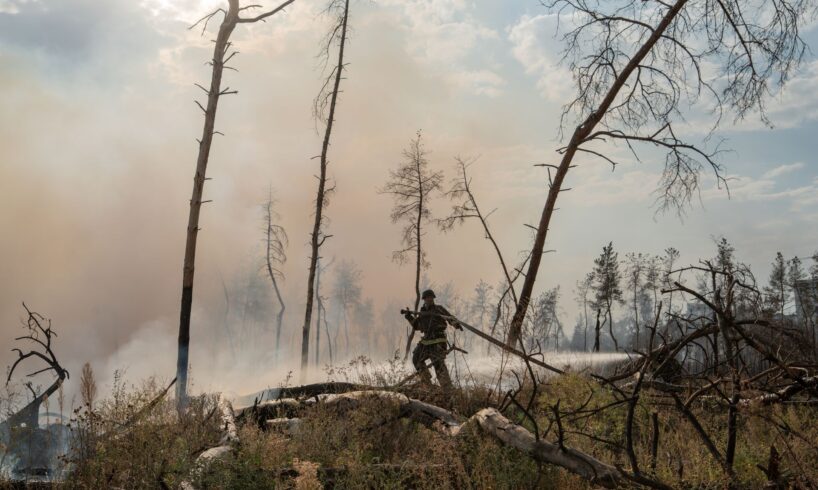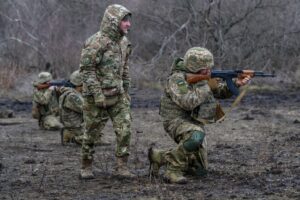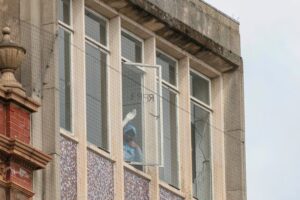
Rescue workers extinguish a forest fire near a shopping center in Kharkiv, Ukraine, on Sept. 17, 2024. (Hnat Holyk / Gwara Media / Global Images Ukraine via Getty Images)
Editor’s note: This story is a collaboration between the Kyiv Independent and the Guardian’s Age of extinction and Ukraine in depth reporting projects.
Natalia Pryprosta was tending her pigs when fire swept into her village of Studenok, near the city of Izium in eastern Ukraine.
There was no time. She grabbed her papers, pulled her elderly mother into a friend’s car, and tried to get the animals out of the shed before they drove off. Smoke and the speed of the blaze made it impossible. She didn’t see the animals burning, but learned of their fate later.
Smoke smothered Studenok, turning the village as dark as night. Pryprosta’s neighbors fought the flames with shovels, digging in scorched earth to stop the crown fire’s advance. Firefighters arrived, but the blaze was relentless. At one point, it surged around a fire truck, trapping the crew.
Mines and unexploded ordnance, left scattered since the Russian occupation and subsequent liberation in 2022, detonated in the heat. Each explosion fed the flames, sending burning debris, branches and embers flying across the village. Trees ignited, and wood fragments were hurled 700-800 meters, recalls Serhii Kohan, the village head.
A fire burns in a forest following Russian shelling in Vovchansk, Kharkiv Oblast, Ukraine, on May 11, 2024. (Yakiv Liashenko / Anadolu via Getty Images)
Only at about 9 p.m., when the wind shifted and the explosions subsided, could the units move in and finally begin to fight the flames. Pryprosta and the other villagers survived, huddled in a neighboring settlement. When they returned, they found many homes burnt, along with blackened trees and mangled structures, another scar on a village already devastated by war.
The highest number of fires on Ukraine-controlled territory this year have been in forests surrounding Izium in Kharkiv Oblast, where Studenok sits, according to the state enterprise Forests of Ukraine. For the first eight months of 2025, Kharkiv Oblast alone has accounted for 60% of all forest fires. The fire that engulfed Studenok in 2024 had ignited in a national park forest about 14 miles (23 km) from the village and swept rapidly north, consuming 6,000 hectares (14,800 acres) as it burned.
Ukraine recorded the most burned land of any European country last year. (Lisa Kukharska / The Kyiv Independent)
Waging war in a tinderbox
Expanding wildfires have become part of the “new normal” in a hotter world. But the scale of burning in Ukraine is extraordinary even on those terms, far surpassing anything witnessed across the rest of Europe. In 2024, nearly a million hectares of Ukraine burned: more than twice the area that burned across the entirety of the EU over the same period.
Analysis by the Guardian and the Kyiv Independent of satellite imagery, monitoring data and on-the-ground testimony connects the devastation of Ukraine’s forests directly to the Russian invasion. The fires have stretched in an arc across the front line of the war in Ukraine. Blazes are concentrated in oblasts in the east, where the majority of fighting has taken place.
The fires in Ukraine are unlike those in Canada and Siberia, where huge areas burn over several months. Monitoring data shows hundreds of small, frequent fires that burn at a low intensity, almost certainly started by explosions. Abandoned farmland that is becoming grassland or young forest accounts for a third of the burned area in 2024. Hot and dry conditions turned the front line into a tinderbox last year, where blasts often became larger fires that were impossible to control safely due to the presence of landmines.
Fires in Ukraine since the beginning of the Russian full-scale invasion in 2022. (The Guardian graphic)
That combination turned 2024 into one of the worst fire years on record in Donetsk, Luhansk and Zaporizhzhia, says James MacCarthy, a research associate with Global Forest Watch. “In Donetsk alone, tree cover loss from fire was more than 40 times the long-term average for 2001 to 2023. Years of conflict, forest degradation and extreme heat have primed these landscapes to burn.”
Rescue workers under attack
National park workers and firefighters say the flames are not the only threat. As they attempt to douse them, they say they are being targeted by Russian drones.
“Drones are always overhead,” says Serhii Skoryk, director of Kamianska Sich national park. “While a few of us put out the fire, two others stand by with rifles, watching to make sure a drone doesn’t fly in and hit the truck.”
Hot, dry weather in 2024 raised the wildfire risk in Ukraine. (Lisa Kukharska / The Kyiv Independent)
Park employees fight fires themselves because the state emergency service considers the territory too dangerous to operate in. At first, they put electronic warfare systems (which jam drone signals) on the fire trucks. But they found the jammers were not working on the latest generations of drones, so turned to borrowed hunting rifles to keep them at bay.
“About 50% of the time, while we’re fighting a fire, a drone flies up to our fire truck and we have to neutralise it,” Skoryk says.
Videos posted by Russian troops on social media show clearly marked fire trucks and personnel being attacked. Often these attacks follow a “double-tap” pattern, with an initial explosion causing a fire, and the same site attacked a second time after rescue and fire crews arrive. One Russian drone-operating brigade in Kherson regularly posts first-person footage videos from drone attacks to their Telegram channel. In one series of clips, the drone pilots target a petrol station, causing a fire. When the fire truck arrives to fight it, a second “suicide” drone flies headlong into the truck, exploding on impact. The Guardian and the Kyiv Independent cross-referenced those videos with photos provided by Ukraine’s state emergency service, of the fire truck’s cab damaged by the explosion.
L: A screenshot from a video showing Russian forces striking Ukrainian firefighters in a double-tap attack following an earlier strike on a petrol station in Kherson, Ukraine, on July 6, 2025. (fobos_herson / Telegram) R: A fire truck damaged in a Russian double-tap strike is seen following an earlier attack on a petrol station in Kherson, Ukraine, on July 6, 2025. (State Emergency Service of Ukraine / Telegram)
While damage and fires are a common consequence of war, deliberately targeting rescue workers, igniting fires or encouraging them to burn in a way that causes deliberate, long-term destruction of the environment would be considered a war crime under international law. The Russian government did not respond to a request for comment.
Across Ukraine, prosecutors are working to determine whether attacks are intentionally targeting natural resources. Trees have provided both sides with cover from drones, making forests a target for deliberate fires, say experts.
“There are no accidental shellings – every strike is a deliberate military action,” says Vitaliy Nikitin, deputy head of the Kherson regional prosecutor’s office. “Every instance of shelling that harms natural resources – from national parks to forests and other environmental sites – is documented.”
Record area of land burned in 2024 despite lower emissions. (Lisa Kukharska / The Kyiv Independent)
Such cases take a long time to investigate. Law enforcement often cannot access sites – many lie in combat zones, where most fires ignite, on mined land or in areas still under Russian occupation. The difficulty, Nikitin says, is establishing a cause-and-effect relationship proving that specific Russian military personnel were responsible for deliberately lit fires or targeting of emergency services.
Anhelina Hrytsei, a researcher with the Ukrainian investigative group Truth Hounds, says reports of attacks on rescue workers intensified in 2024 and 2025.
The precision of the weapons, absence of nearby military targets and repeated use of double-tap tactics point to deliberate targeting, she says.
“If a small drone with a camera is used to attack rescue workers, and the operator can see them on site wearing insignia, then we can talk – if not about intent – at least about a failure to prevent harm.”
Local resident, helps to put out the fire in the wheat fields, burning after the shelling in the village of Nova Poltavka, Donetsk Oblast, Ukraine, July 2, 2024. (George Ivanchenko / The Kyiv Independent)
Agriculture under threat
Most large forest fires occur near active combat zones, where a variety of explosive objects litter the ground. Landmines and unexploded ordnance left from occupation or failed detonations can ignite in the heat, fuelling fires and making firefighting extremely dangerous.
Russian forces also carry out remote mining, including anti-personnel mines known as “petals”, dropped from drones.
“Once we demined this 8-hectare area near a road. A few days later, petals were already lying there,” says Skoryk. During hot, dry summers, the ammunition can heat and spontaneously detonate.
The mines and ordnance also slow firefighting. In the front-line Izium Forestry, where about 90% of the territory remains mined, pyrotechnic units must inspect the area before crews can begin extinguishing.
More than 2 million mines have been laid in Ukraine, making it one of the most mined countries in the world, and researchers say it will be difficult for the land to recover quickly.
A third of Ukrainian land burned in 2024 was agricultural. (Lisa Kukharska / The Kyiv Independent)
“Remaining mines and unexploded ordnances in forests along frontlines will prevent recovery and active reforestation of this land for a long time,” says Peter Potapov, a researcher at World Resource Institute’s Food, Forests and Water program.
Many of the country’s forests were planted and carefully managed alongside farmland, he says, to calm wind, hold snow and regulate water runoff. “Without these forests, the agricultural productivity may be reduced at the regional scale,” he says.
Biodiversity shattered
Burning at such enormous scale and intensity, the fires could have long-term effects on the biodiversity of Ukraine, scientists say. “War affects nature in a complex way – every part of the ecosystem suffers,” says ecologist Kateryna Polianska. “Some changes can be reversed, but others will not recover, or only with great difficulty.”
In 2024, Polianska travelled to Sviati Hory national park and the Kreidova Flora department of the Ukrainian Steppe nature reserve, areas scarred by the war. There, relict chalk slopes – ancient formations created millions of years ago – were shattered by shelling. “We will no longer be able to reinforce them, put them up,” she says.
These slopes once sheltered rare pine forests on chalk, recognised as an endangered habitat. Now, many forests lie burned, broken or stripped bare. Polianska warns that climate change makes recovery even harder: “It may take 70 or 80 years to see the same forest – if it recovers at all.”
For Skoryk, the destruction is personal. The Kamianska Sich national park director lost his home when Russian forces occupied it in 2022 and he now lives in a basement on the park’s grounds. Despite everything, he refuses to leave.
“This is my child, I created it – I have been the only director since the day it was founded,” Skoryk says. To him, the park is a life’s work, a place where rare species and fragile ecosystems depend on protection even under constant attack.
Fires sparked by shelling regularly sweep through the park, threatening what remains. After the dust settles, craters maintain dangerous levels of heavy metals from explosives and toxins. Skoryk and his staff trained in mine clearance and continue to work on demining parts of the park whenever possible – between fires and after marked craters have been studied for measurements and samples.
“If not us, who?” he says.
The land is burning after the shelling in the village of Nova Poltavka, Donetsk Oblast, Ukraine on July 2, 2024. (George Ivanchenko / The Kyiv Independent)
Note from the author:
Hi, this is Linda. Thank you so much for reading! While reporting for this story, I’ve been deeply impressed by the bravery and dedication of park and forest workers who continue their work despite constant danger. In Kamianska Sich Nature Park, some are stationed just four kilometers from Russian forces. They conduct research, protect endangered species, and often fight fires themselves, simply because it must be done. Their efforts shouldn’t be forgotten.
If you’d like to support our work and empower us to do more stories like this one, please consider becoming a member of the Kyiv Independent.





